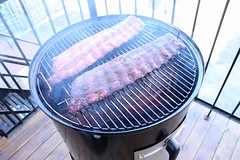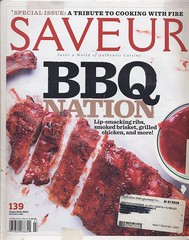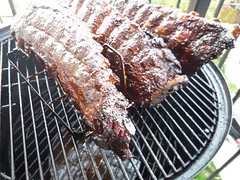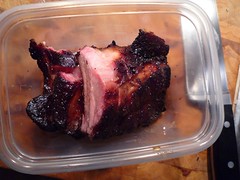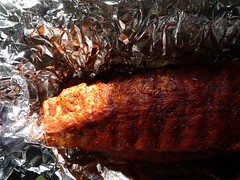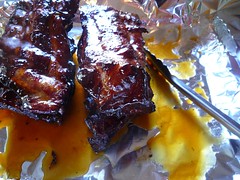Thanksgiving Just Keeps on Giving
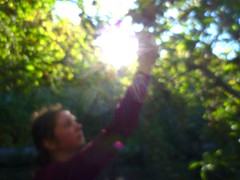 fig. a: apple-picker
fig. a: apple-picker
Canadian Thanksgiving 2013 began with our annual apple-picking excursion to Covey Hill. There, we picked a couple of buckets of apples (Empires, Northern Spys, Russets, and Spartans, mainly), bought a couple of baskets more,
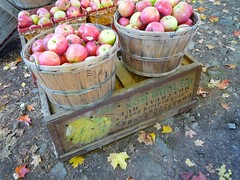 fig. b: apples
fig. b: apples
and picked up some Flemish Beauty pears, as well.
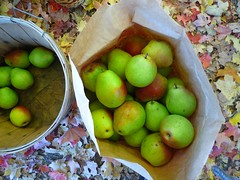 fig. c: pears
fig. c: pears
The sun was bright, the leaves were vibrant, and it was downright warm (felt more like peach-picking weather than apple-picking weather), and we got a chance to get all caught up with our good friend M. Safian. And on the drive back we started thinking about all the possibilities we now possessed in the back of our car: apple pie, baked pears, apple strudel, pear chutney, corn bread stuffing, squash soup, and so on.
The next day, when we actually got around to making our Thanksgiving meal, it was quite the spread. Not surprisingly, both apples and pears played an important part.
The menu:
smoked Cajun andouille appetizer
sweet potato & peanut soup (with apple cider)
roasted turkey
corn bread stuffing (with apples & pears)
roasted romanesco cauliflower
roasted Brussels sprouts
roasted carrots
mashed potatoes (with turnips and parsnips)
cranberry sauce
Georgian plum sauce
mixed greens salad (with apples & pears)
cheese plate (with pears)
apple pie
pumpkin pie
Our turkey this year was a huge hit--it was also just plain huge. When Michelle heard through the grapevine that Société Orignal was offering turkeys raised by the one-and-only M. Bertrand, she put through an order for a "small turkey" immediately. The turkey that she received was beautiful, and unbelievably fresh (it had just been slaughtered two days before), but it was also almost 20 pounds (!)--the very largest we'd ever made, and not exactly the ideal size for our preferred high-temperature turkey method. Nevertheless, we soldiered on. And by now Michelle's got this approach down to such a science that the results were truly phenomenal. Two tricks of the trade:
1. Salt your bird generously, inside and out, at least one day in advance, and preferably two.
2. When you bring your bird to room temperature before roasting it, cover the bird's breast with ice packs to keep it cool. Remove the ice packs right before roasting. Doing so will ensure that the breast meat does not get overcooked, but instead will turn out juicy and succulent (already, even without this fix, we found that the high-temperature method produced the juiciest birds we'd ever encountered, but if you're roasting a larger bird, like we were, this step is essential).Our cranberries were pretty special, too. They came from Société Orignal, as well, and they were dry-picked, not wet-harvested. Neither of us had ever tasted a cranberry sauce with a deeper flavour.
Our stuffing was also rather deluxe. I've been trying to convince Michelle of the merits of corn bread stuffing for years, but she's always remained steadfastly loyal to stuffing made with white bread or sourdough. This year amounted to a breakthrough, though. Michelle officially declared this year's model to be her very favourite of all-time.*
AEB Corn Bread Stuffing
1 extra-large 3x batch of corn bread
onion
celery
red sweet peppers
parsley
sage
roasted hazelnuts
2 chopped apples
2 chopped pears
bourbon
salt & freshly ground black pepper
butter
Preheat oven to 425º F.
Sauté the onion in butter until translucent. Add the celery and red peppers and continue sautéing until softened. Add the corn bread, the herbs, the nuts, and the fruit and mix gently but thoroughly (preferably with your hands, once you've allowed the onion mixture to cool slightly). Adjust the seasoning with salt & pepper. Spritz liberally with bourbon. Pour a generous amount of melted butter over top and mix again. The stuffing should be just slightly moistened by the combination of bourbon and butter.
Place in a buttered baking dish and bake for 30 minutes covered in foil, and 15 minutes uncovered.Anyway, we thoroughly enjoyed our meal, everyone ate heartily, and we had so much left over that we sent our guests home with doggy bags--and still we had copious leftovers. The ultimate prize, however, was that massive turkey carcass. It still had a fair bit of meat left on it, and it had been roasted to perfection--in other words, it had all the makings of a beautiful batch of turkey broth. So I cut it up into portions, put them in bags, and froze them.
And the next week, when all the other leftovers had disappeared days ago, and my taste for turkey was coming back to me, I got to work on my new (since last year) favourite post-Thanksgiving ritual: making turkey gumbo.
Thing is, because making turkey gumbo is "my new... favourite post-Thanksgiving ritual," I was already thinking about the gumbo before we'd even roasted our bird. And because I knew I wanted to make my turkey gumbo with real Cajun andouille (a spicy, smoked Louisiana classic), and I was pretty sure locating real Cajun andouille would be a little difficult 'round these parts, I made my own. Then, because I was smoking anyways, I decided to smoke some additional turkey legs, just for the hell of it (and in case my turkey gumbo needed to be bumped up a little). So on Thanksgiving Sunday, while Michelle had the turkey in the oven, I had the smoker smokin' away--which is how we ended up serving freshly smoked andouille as an appetizer.
How, exactly, do you make Cajun-style andouille? Well, I based my batch on a recipe from Bruce "America's Premier Sausage Maker" Aidells:
Cajun-style Andouille
3 tbsp sweet Hungarian paprika
2 tbsp minced garlic
2 tbsp kosher salt
2 tbsp sugar
1 tbsp freshly ground black pepper
2 tsp ground cayenne pepper
1 tsp crushed red pepper flakes
1/2 tsp dried thyme
1/4 tsp ground mace
1 tsp curing salts (optional--for cold-smoking only)
5 lbs pork butt, fat and lean separated, and cut into 2" chunks
1/2 cup water
wide hog casings
Mix all the spices and herbs in a small bowl. Separate the meat and the fat into two bowls, and rub each thoroughly with the spice mixture. Cover and refrigerate overnight.
Grind the lean meat in a meat grinder using a 3/8 inch plate. Grind the fat using a 1/4-inch plate. Mix the meat and fat together in a large bowl, add the cold water, and knead and squeeze until the water is absorbed and the spices are thoroughly blended.
Stuff the mixture into wide hog casings, and shape into medium-sized links.
If you are hot smoking, dry for at least two hours in a cool place, then hot smoke at about 225º F, turning every 30 minutes, until an instant-read thermometer inserted in the end of a sausage shows 155º to 160º F. This should take about 1 1/2-2 hours.
If you are cold smoking, you'll have to add the curing salts during the first step, and carefully follow instructions on how to cold smoke. Aidells recommends an extra-long cold-smoking period for Cajun andouille: "at least 12 hours" (!).
Hot-smoked andouille sausages are ready to eat as soon as they've been smoked. Cold-smoked sausages are not--they must be fully cooked first.
[recipe from Bruce Aidell's Complete Sausage Book]
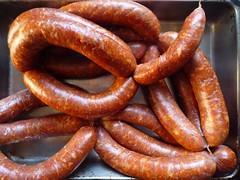
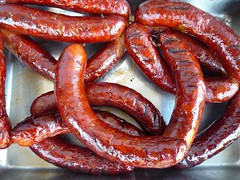 figs. d & e: andouille: before & after
figs. d & e: andouille: before & afterWhile you're at it, might as well smoke a few turkey legs, right? Just brine them for at least a few hours, and preferably overnight, then hot smoke them alongside your sausages, making sure to mist them with apple juice every 30 minutes or so. Smoke until the juices run clear when you slice down to the bone, about 1 1/2 to 2 hours.
The results? The skin turned out a little rubbery, but the meat was dreamy: incredibly juicy and wonderfully smoky. I just peeled the skin off and sliced the meat as thinly as possible before serving. And I made sure to keep some for my gumbo.
 fig. f: smoked turkey
fig. f: smoked turkeyAEB Turkey & Sausage Gumbo
for the broth:
1 turkey carcass (recuperate as much quality meat from this carcass as possible, and put aside for the gumbo)
onions
carrots
potatoes
celery
garlic
2 bay leaves
12 peppercorns
salt to taste
Make yourself a rich turkey broth by adding all the ingredients above to a large stock pot, covering with water, bringing the pot to a boil, and simmering for at least a few hours. Make sure to skim the fat thoroughly. Turkey broth might be my absolute favourite, and this method ought to produce much more than the 4-5 cups of stock you need for the gumbo. Freeze it and save it for another worthy occasion.
for the gumbo:
recuperated turkey meat from the carcass
recuperated meat from home-smoked turkey pieces (optional, but highly recommended)
bones from home-smoke turkey pieces (again, optional, but highly recommended)
4 smoked Cajun andouille sausages (highly recommended), or some other quality smoked sausage (like a kielbasa, for instance), cut into 1/4" "coins"
1 batch Cajun roux (made with 1/2 cup vegetable oil and 1/2 cup AP flour [you can find complete instructions on making a true Cajun roux here])
1 large onion, diced
3-4 stalks of celery, diced
2-3 sweet red peppers
1 green pepper (preferably something flavourful, like an Italian fryer or a cubanelle)
4-5 cups rich turkey broth
2 bunches scallions, white & green parts, washed & chopped
1 small bunch fresh parsley, chopped
4-6 fresh sage leaves, julienned
kosher salt & freshly ground black pepper
1 tbsp gumbo filé
As John Thorne would say, "First, you make your roux." When your true Cajun roux is as deep and dark as you like it, add your chopped onions, turn the heat back up to medium or medium-low, and sauté until soft. Add the celery and peppers and sauté for a few minutes more.
Slowly add the broth and stir or whisk it in carefully, so that your roux doesn't separate.
Add the bones from the smoked turkey pieces (if using), the scallions, parsley, and sage and bring to a boil, then turn down the heat and simmer your gumbo gently for about 1 1/2 hours, or until it shimmers. Afterwards, if it needs to be skimmed of excess fat, do so.
Add your turkey meat and your andouille. Stir in the gumbo filé and simmer gently for another 30 minutes. Adjust the seasoning, if need be.
Serve over or alongside steamed white rice, with some cold beers, and have a bottle or two of hot sauce on hand for anyone who wants to bump up the spice quotient a bit higher.
Note: Of course, you don't absolutely need a leftover turkey carcass to make this gumbo, nor do you need to make your own smoked andouille. You could easily make something that's nearly as tasty with fresh turkey or chicken pieces, some store-bought smoked sausage, and some chicken or poultry stock. But making full use of your leftover Thanksgiving turkey and its carcass is pretty satisfying, and few dishes make it shine like a turkey & sausage gumbo.
[recipe inspired by one that appeared in the November 2011 issue of Garden & Gun, and that came from Justin Devillier of New Orleans' La Petite Grocery]And when I'd eaten turkey & sausage gumbo for two days (and loved every minute of it), I made leftovers with my leftovers: Cajun-style hot turkey sandwiches. Mmm-hmm. Laissez bon temps rouler!
AEB Cajun-style Hot Turkey Sandwiches
leftover Turkey & Sausage gumbo, with lots of sauce
1 or more slices of white bread (preferably a homemade sourdough)
Heat up your leftover gumbo. Place a slice of white bread on a plate. When the gumbo has been heated through, pour it over the slice of bread, making sure the entire slice is covered in sauce. Serve immediately, preferably with boiled and buttered peas and mashed potatoes.
aj
* Of course, I'm pretty sure she does that pretty much every time we make stuffing of any kind. We're both huge fans of the genre.
